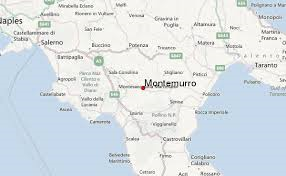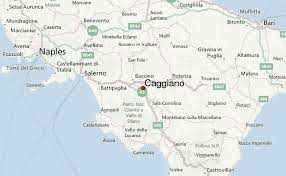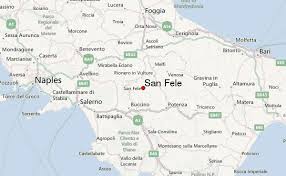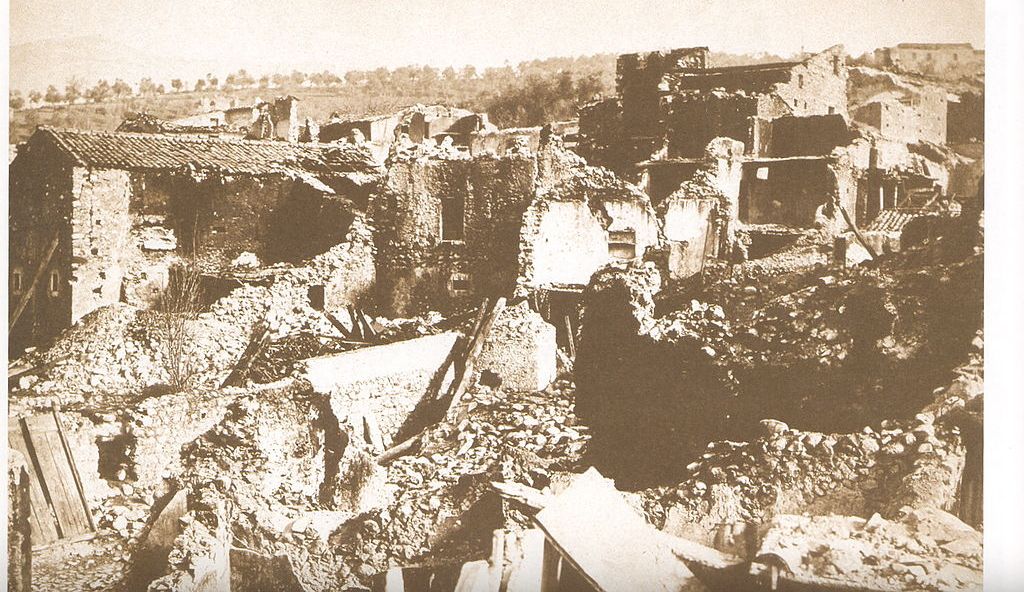


The Great Neapolitan Earthquake of 1857 Part 1
By: Tom Frascella January 2015
Introduction
Few events have had greater impact on the region of Lucania, its residents and events beyond its borders than the Great Neapolitan earthquake of 1857. Yet few people today are even aware that such a catastrophe occurred in Basilicata 158 years ago. One obvious reason for this lack of awareness is the event’s historic name. Today catastrophic events such as earthquakes are generally called by the name of the area in which they are centered or the closest town or city to the event. No such naming tradition existed in 1857. As a result the historic name, Neapolitan Earthquake, suggests to the modern reader that the earthquake centered in Naples, not Basilicata.
The Italian earthquake of December 1857 centered in the southwest corner of the Provence of Potenza, State of Basilicata in the Kingdom of the Two Sicilies. The City of Naples suffered no fatalities and minor if any property damage during its occurrence. Naples was over fifty miles from the zone of destruction which extended from the epicenter about 25 miles outward.
Earthquakes, unfortunately, are a frequent occurrence to the southern region of the Italian peninsula and on the island of Sicily. Volcanos, natural geologic fault lines and continental plate movement are a part of the geographic composition of the region. Occasionally these natural anomalies exert enormous internal pressures and then release through the ground incredible energies with catastrophic results.
In Basilicata, for example, a major earthquake, defined as one causing tens of millions of dollars in property damage and killing as many as 50 to 1,000 people has occurred on average every 50-80 years for the past several thousand years. People in the region live with this knowledge. The last major earthquake in the Basilicata region occurred in 1980.
A “Great” earthquake however is of a magnitude many times that of a “major” earthquake. A Great earthquake causes billions of dollars in damage and results in the death of tens of thousands of people. Great earthquakes have been occurring in the Basilicata region on average every 300-500 years. The last Great Earthquake in Basilicata being that which this article is written occurred in 1857. But Basilicata is not unique in experiencing “Great” Earthquakes as the surrounding southern Italian States have suffered their share as well.
The format and limitations of this website do not allow for an in depth analysis of a catastrophe of the magnitude of the earthquake of 1857. But the event is of such importance to the history of Lucania and Lucanian immigration that it does need to be referenced, described and included in our website history. Without inclusion of this event subsequent events cannot attain proper context in the region’s history. In order to focus on the event in an organized manner I have decided to divide its discussion into three parts. Part 1 will tackle the earthquake event itself, what happened in broad general terms in the region. Part 2 will discuss the aftermath of the quake, the response of the residents to the disaster, local and federal response to the event and the international response. Part 3 will discuss the place the event holds in the development of our modern understanding of the geophysics of an earthquake event.
Part 1
No modern scientific study of an earthquake event had ever been conducted prior to the 1857 earthquake in Basilicata. This 1857 event actually served as the initial post-earthquake event study in the field. Shortly after the earthquake struck in mid-December 1857 the Royal Society of London commissioned engineer Robert Mallet to conduct an in depth scientific study. Mallet arrived in Italy in early 1858. Mallet was a well-known engineer in London who had participated in the design of several of the bridges across the Thames River. A great deal of his report focuses on structure collapse and wave patterns of collapsing buildings and mountainsides. Toward this end his training as a structural engineer was very helpful. Since he was the first to attempt such an analysis of the event Mallet’s study of the event led him to some interesting and sometimes disputed theories on what occurred or occurs during an earthquake event. It should be appreciated that his observations were obtained at ground level and with very little instrumentation available. As time and understanding of quake events has evolved Mallet’s study remains the first important attempt at understanding the event but not the definitive modern concept.
In addition his study of structural responses during the quake led to discussions regarding building design. Continuing work to minimize damage and avoid collapse is the focus of much work worldwide. Part of Mallet study and attention to detail led to his commissioning a French photographer to go to certain areas of the quake that he had surveyed in Basilicata. These photographs were the first photographs illustrating earthquake damage ever made.
As I stated above, southern Italy has experienced regular earthquake occurrences, major and great, throughout its history. For example, in the 125 year period between 1783 and 1908 excluding “major “ quakes southern Italy experienced four “Great “ earthquakes. They are by region the Calabrian earthquake of 1783 with between 32,000 and 50,000 deaths, the Lucanian earthquake of 1857 with between 11,000 and 19,000 deaths, the Calabrian earthquake of 1905 with between 3000 and 5,000 deaths and the Messina/Calabrian earthquake and attendant tsunami of 1908 with around 125,000 deaths. As you can see from the numbers the catastrophic nature of these events cannot be overstated. The human loss was enormous. Unfortunately the exposure to future such events remains highly probable.
One area of confusion concerning the earthquake of 1857 is the time it occurred. In Mallet’s report he does note that the local residents placed the major tremor strike at two different times, 5 p.m. and 10 p.m. Over time the earthquake of 1857 was generally reported as occurring at 10:00 p.m. on December 16, 1857. For a long time the two different times were regarded as a major event followed by a very strong aftershock.
Mallet’s report does pick up on the fact that minor pre-quake tremors were noted in early December starting some two weeks before. The two December 16th events were followed by aftershocks, some quite violent, that continued to occur for months. The reports of multiple major tremors on December 16th gave rise to decades of speculation as to the exact time that the major earthquake event struck and brought into question what was after shock versus primary event.
Today scientists think that two distinct earthquakes occurred on December 16th one centered at Montemurro in the southwest corner of the Provence of Potenza and a second at the town of Caggiano to the northwest of Montemurro about twenty-five miles away. Caggiano is about fifteen miles directly south of San Fele and so the second epicenter was relatively close to the commune. If a circle with a radius of about twenty-five miles is drawn using the two towns mentioned above as center then one can identify the region of greatest loss of life and property from this quake. Indeed about ninety-five per cent of the deaths and property damage which occurred in this quake would be located within those two circles.
Anyone who has been to this area knows that the affected area described above is primarily mountainous. The resident population of the principle zone of destruction was probably not more than 150,000-200,000 people with the majority residing in small farming hamlets or towns scattered about. On the one hand the relatively small population residing in the area contributed to a lower death toll of 10,000-19,000 people. On the other hand 10,000 to 20,000 killed out of a 150,000-200,000 person total population is an unimaginable per capita ratio.



Maps of Basilicata region showing Montemurro, Caggiano and San Fele
Mallet examined the affected earthquake region by a route that had him leaving the coastal plain at Eboli and using the mountain passes to head toward Montemurro. From there he explored the region moving northward as far as roughly Melfi. He then headed back completing his circle by using the pass near San Fele on his return to Eboli.
Two epicenters located in the remote mountainous regions also meant that the affected communities were scattered and hard to reach for both rescue and recovery of victim. Mallet in his writings reports on some of the travel difficulties although his visit is three months after the event. Even communications between local communities which could indicate the place where aid was most needed was stifled by the elements of location and weather in the winter of 1858.
The question arises as to what factors amplified this decimating human regional catastrophe beyond the event itself. The first factor is that the region is poor, primarily agricultural, and the majority of the population lived in stone, poorly maintained, heavy tiled roof structures. These structures tend to experience roof collapse and wall collapse when subjected to the type of tremors at play during the 1857 earthquake. Coupled with this was both the time of year and the time of day the earthquake struck. December 16th is winter up in the Apennine Mountains. Although this is southern Italy the mountains reach freezing temperatures with snow and ice in winter. By late afternoon and evening in this region the residents were inside preparing evening meal or in bed. This left most of the population more vulnerable when the building collapses occurred. Add to this that survivors had to scramble from collapsing buildings wearing only bed clothing into freezing weather, in the rural darkness. The conditions inherent in when the earthquake struck exacerbated a terrible, deadly and freighting experience and slowed the immediate efforts at rescue of survivors.
Before Robert Mallet could survey the affect territory he had to obtain authorization from the Bourbon authorities in Naples. A request for access for purposes of scientific study had no precedent in history but the Bourbon authorities approved the endeavor without presenting any obstacle. This would suggest that the Bourbon authorities were interested in understanding better the mechanics of these types of events. In part 3 of this article which examines the developing science we will see that indeed there was an interest in increasing scientific knowledge fostered within the Kingdom of Naples. It is important to note this as this fact gets lost in the British Press.
In fact, given the way some aspects of his report were used in the British press in 1858-1860 one must question whether Mallet’s very commission to study the event hid secondary political motives beyond scientific research. The British government was hostile to the Bourbon regime and the way the report was used reflects that. However, I don’t think that the British government’s use of the report should diminish the report as standing out as a first in an emerging field of geophysical study.
The report also provides several valuable accounts from survivors and invaluable first hand observations which help draw a picture of the conditions and suffering of the local residents.
One story which demonstrates how little time the locals had to respond once the quake struck was of a couple who were in bed, their teenage daughter also in bed in the next room when the earthquake struck. The wife/mother was able to escape the collapsing roof by jumping out the window. The husband and daughter were trapped alive under the roof debris. In the light of morning 10 hours later villagers were able to rescue the husband alive but the daughter had died. The father reported that during the night he could hear his daughter calling for help initially but when a second tremor struck her cries went silent under the sound of additional collapsing roof.
In another town he visited as part of his tour that February 1858 he was told of a young mother and infant child. The mother was forced to abandon the infant as the home collapsed. Inconsolable at first light the woman entered the partially collapsed structure moving debris by hand until she was able to find the infant, miraculously alive. Unfortunately, as she attempted to leave the structure, infant in her arms, another wall collapsed and both were killed.
Mallet reported that even two months after the quake when he toured the area walls were subject to sudden and unexpected collapse. This not only presented a danger to the locals as they attempted to repair their lives and homes. This condition represented a real danger Mallet from which he narrowly escaped on several occasions. He had no alternative when gathering data on the shock waves of the quake and directionality but to climb about the ruins. Much of his calculations were necessarily based on his measurements and observations of the patterns of masonry fissures and direction of collapse of buildings. The structures still standing were dangerously weakened with centuries old mortar. In addition he made observations concerning the presence of softer soil and rock types which were prone to landslides. These he could observe by direction as he passed through towns mountain passes and occasionally climbed mountain peaks.
I should point out that he did make an interesting observation and entry regarding the people of San Felese which I will get to in Part III. I believe near the end of his tour he spent about a day in the valley of the commune in Pierno. He was delayed there by winter conditions in the pass.
As I noted the geography of the region and the time of year continued to exacerbate the conditions that the local population of the region had to endure in the aftermath of the earthquake. For the most part the larger towns are built, for defensive purposes at the higher elevations above the valley farmland. Usually there is one steep narrow roadway up and down carved into the mountainside. There is a distance between the main town center and the valley hamlets which impaired help from reaching impacted structures in both directions. In addition, in some cases rock slides buried the access roads making it more difficult to move people around within the communities and up and down the mountains. As between communities, people depended on the passes within the mountain range to get from town to town. In winter not only were passes periodically closed by ice and snow but now additionally by mud and rock slides. In the 1850’s there was no heavy equipment to speak of for rescue of injured or clearing of roads and buildings. The people were essentially on their own with only their own labor and hand tools to work with. Rescue and recovery progress was frustratingly slow.
Essentials such as food and medicines were never in great supply due to the poverty inherent in the region. Much of the stores of essentials that the population needed to survive the winter were out of reach after the quake. Many of the storerooms were either destroyed in buildings damaged by the quake or unreachable. The people of the region faced each dawn immediately after the quake in shock, grief, hunger, pain, despair and bitter numbing cold.
Again, Mallet’s report on conditions in the region in February 1858 allows us some sense what it was like two months after the quake struck. As he traveled in the tight damage circle of the quake he was careful to avoid being out on the road as evening fell. He gives as the principle reason not wanting to be caught out in the open at night as temperatures consistently dropped well below freezing. Another reason that I have read from other accounts is roving packs of wolves emboldened by the reduction in shepherds guarding their flocks and the availability of human corpses to scavenge made such exposure dangerous.
Mallet also recounted a scene as he approached Montemurro which is where one of the epicenters was located. He recounted that as he approached the town he was met by a number of local policemen carrying pallets upon which a number of bodies were laid. He obviously was pointing out that the locals were still digging out bodies from the debris for burial three months after the quake struck. Frequently when Mallet does discuss staying in one of the towns at night the structure is something like a hall that the locals are using as emergency shelter. There is no heat, the building may have walls missing and be open to the outside. Such was the nature of the accommodations available.

Photograph of the town of Pertosa near Caggiano after the 1857 quake. Pertosa is 15 miles south of San Fele.
With respect to weather and travel conditions, Mallet reported that in late February as he moved southward toward Eboli he found the way near Pierno was blocked by six to eight feet of snow. The snow was so deep that it was impassable for his donkeys the only effective mode of carrying supplies. He explained that the winds often whipped the snow from the upper elevations adding to the accumulations below in the valleys and passes.
The observations that Mallet made on the conditions in the region three months after the earthquake help in understanding how the local residents must have felt and what the Bourbon government’s response to the crisis was or maybe more accurately was not. Some of his observations were clearly used by the British government and English press in attacking the Bourbon regime as uncaring or removed. Whether this was “fair” criticism or propaganda used by the British government to raise up anti-Bourbon sentiment within the British population is an interesting question.
In all a summary of the British critic of the Bourbon response can be reduced to: 1. The Bourbon Government failed to act quickly, responsibly/humanely and adequately. 2. That the Bourbon government “Intentionally” understated the magnitude of the catastrophe by grossly underestimating the death toll and property damage. I think that the criticism of the adequacy of the Bourbon response to the catastrophe has a great deal of merit. However that response when framed in the context of 19th century Europe and its resources is probably less shocking than played in the British press.
First let’s consider Rescue. As we have seen from modern catastrophes involving trapped people in collapsed buildings the window of rescue is relatively small at best four to twelve days depending on weather. In the case of the 1857 earthquake which struck in winter in the mountains the expectation that a response force of federal manpower that could reach this remote high region in time was probably beyond the Bourbon government’s ability. Those that were going to be rescued realistically only had local resources to depend on. As to those rescued or suffering crushing injuries, medical science at the time provided little if any useful help. The fate of those in immediate survival peril probably could not have improved based upon outside help.
In my opinion where the Bourbon government failed and cost hundreds and perhaps thousands of lives was in failing to provide temporary shelter and adequate food supplies in the winter and spring months that followed. This failure led a population of grief stricken and starving people to reach levels of frustration, anger and despair which boiled over into civil unrest and in some cases riot and looting.
The casualty figures gathered by the Bourbon government have been highly criticized. The “official” death figure of 11,000 people killed in the quake seemed wrong as pointed out by Mallet in his report. Mallet put the estimate at closer to twice that amount. According to burial records accumulated by the Catholic Church the “unofficial” count was 19,000.
There may be several reasons for the discrepancy. The Bourbon government’s figures may be based solely on those who died in the quake itself. Therefore they may not count those who died of injuries, starvation and cold in the months afterward. In addition, there is the suggestion from several sources that the government received their figures from larger communities only and did not take into account the smaller more isolated communities in their calculations.
In the British press the underestimating was portrayed in the most sinister light. In essence the press suggested that the discrepancy was the result of intentional lack of concern for the populous. Further that it somehow permitted the Bourbon government to downplay the magnitude of the relief that was urgently needed in order to divert resources elsewhere.
Motivations aside the criticism that the Bourbon government did not provide any measurable organized relief to the area during the winter and spring of 1858 seems largely correct. Additionally there was no international response to speak of. British citizens living in Naples as well as other foreign nationals residing in Naples did voluntarily organize some food relief. However this was on a very small scale and primarily only reached people on the fringe of the destruction. Access to the interior of Basilicata where the greatest damage was felt was hampered by road blockage.
The Bourbon government seems to have waited until civil unrest began to rise within Lucania before marshalling any significant response to the crisis. To the extent that there was a response it did not arrive in scene until the spring of 1858. Unfortunately the government’s response was to send 5,000 troops in to quell the unrest rather than to relieve the starvation and misery. Imposing Marshal Law led to mass arrests, greater resentment against the Bourbon regime and civil disobedience. This intern led to a cycle of greater suppression by the soldiers. Eventually there was increasing flight of those accused of breaking the law into the hills and mountains of Lucania. Effectively the show of force and its enforcement doubled to about 2,000 the number of desperate poorly armed “rebels” up in the mountains. In other words the Bourbon response initiated a people’s revolt in the region.
This “people’s revolt” was very different than what had previously occurred in the region. Lucania like the rest of Italy had experienced Carbonari “revolts for the previous sixty years. The Carbonari revolts were essentially middle-class and upper-class revolts which focused on civil rights and liberties for those classes of people. The poor never felt as if the Carbonari movement held any advantage for them and so didn’t participate. Since the earthquake and its damage cut across class lines, the suppression imposed on starving people and the abuses of the soldiers did as well. The poor had never felt that they had anything to gain in the Carbonari revolts but suddenly found common ground with other who were disenfranchised and living as rebels in the hills.
The universality of these “aggrieved” together with the universality of the suppression of the general population in Lucania produced a unique circumstance. The uniqueness or universality of the affected would create a core of resistance that carried forward post-unification. This difference in the nature and composition of resistance would have devastating impact on the future of Basilicata into the present.
In the next section of this article Part 2 a major topic will be displacement. In major catastrophes there is always disruption and displacement. The Earthquake of 1857 is no exception. What is unique however is that for the first time a small amount of the displacement of people resulted in arrivals in America. This pattern of refugee immigration, on a grander scale, would be repeated in subsequent southern Italian earthquake events. The earthquake of 1857 holds the distinction of being the first to open the avenue of relief.
© San Felese Society of New Jersey